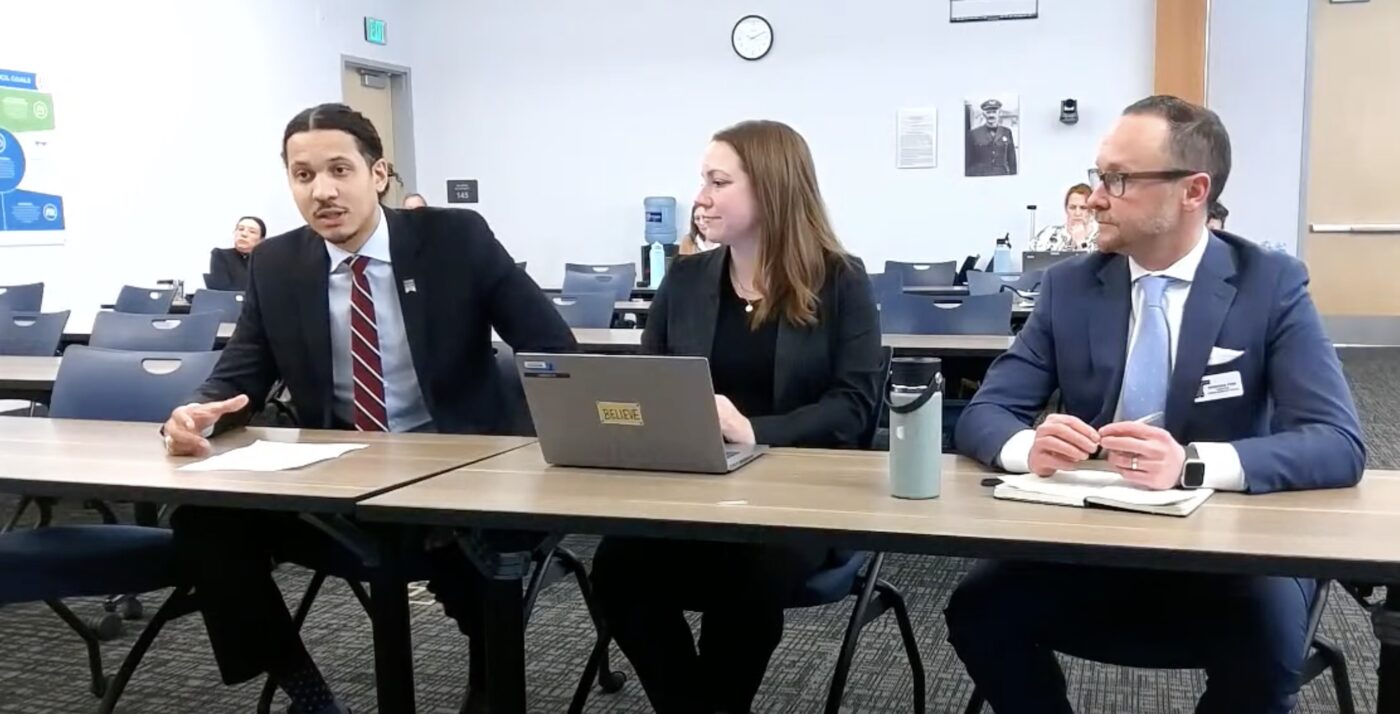 Albina Vision Trust Strategic Communications Director JT Flowers (left), along with ODOT Rose Quarter Project Manager Megan Channell and ODOT Urban Mobility Office Director Brendan Finn at an Oregon Transportation Commission meeting in Medford Thursday, March 14th. (Photo via YouTube screenshot)
Albina Vision Trust Strategic Communications Director JT Flowers (left), along with ODOT Rose Quarter Project Manager Megan Channell and ODOT Urban Mobility Office Director Brendan Finn at an Oregon Transportation Commission meeting in Medford Thursday, March 14th. (Photo via YouTube screenshot)
“The Albina Vision Trust has consistently proven to be both the backbone and the wings behind this project.”
An unlikely partnership between a state agency and a Portland-based nonprofit that could have vast implications for the future of the Rose Quarter took a big step forward last Thursday.
At a meeting of the Oregon Transportation Commission in Medford, Albina Vision Trust and the Oregon Department of Transportation received official approval to develop a work plan for how the future cover over I-5 will be governed. Specifically, the resolution passed unanimously by the five OTC members says that AVT and ODOT now have 60 days to hammer out a plan that determines, “If AVT can have access and rights to the future lease(s) and/or easement(s) for developable air rights on the Project’s highway cover and ownership and development rights for surplus property associated with the Project.” And if current laws and regulations don’t allow AVT to be granted those rights, the plan will determine how to change the law to make it possible.
It’s an unprecedented step that’s likely to put AVT in the driver’s seat of the $450 million investment into lower Albina — the largest federal grant ever received by ODOT — and that sets into motion the largest redevelopment project of its kind in America today.
It’s the latest in a string of eye-popping wins by AVT, a nonprofit that launched in 2017 with a bold idea to recreate the bustling community that once thrived in lower Albina before construction of I-5 and other developments displaced hundreds of Black Portlanders. In February, AVT convinced Portland Public Schools to relocate their headquarters and sell their building to the nonprofit, who plans to build 1,000 units of “working class housing” at the location. And shortly after that move, AVT won $25 million from the Oregon Legislature for the PPS project. The $450 million grant from the US DOT’s Reconnecting Communities and Neighborhoods grant program was coupled with an additional $38 million City of Portland grant to rebuild and redesign NE Broadway and Weidler from 7th to the Willamette River through the Rose Quarter project area.
Now, as you’d expect for an organization with this many accomplishments under their belt, AVT is leaning into their power. AVT’s Strategic Communications Director JT Flowers told members of the OTC Thursday that his group, “Has consistently proven to be both the backbone and the wings behind this project.”
Just five years ago, AVT used that backbone to publicly challenge ODOT because of the agency’s initial reluctance to invest in highway covers that would be robust enough to hold multi-story buildings. That squabble seemed very far in the rear-view mirror Thursday, as Flowers sat next to ODOT Urban Mobility Office Director Brendan Finn and Rose Quarter Project Director Megan Channell at the OTC meeting. The trio beamed as they shared news of the federal grant and shared their work plan proposal with transportation commissioners.
“I think the project is a prime example for how community building and partnership goals are well aligned with transportation infrastructure investment,” said Channell, “and we see the Rose Quarter project as an opportunity to be a national model for how it can be a ‘yes, and’ instead of just an ‘either, or'”
No one at Thursday’s meeting uttered the word “freeway” or mentioned anything about ODOT’s plans to significantly widen I-5 between I-84 and the Fremont Bridge. However, Channell might have been referring to it when she said, “It wasn’t that long ago that we were having different conversations in front of you and we were not in alignment on a project design, nor did we have the project partnerships to move forward. So I feel like we’ve worked very hard to incorporate the perspective of our partners of our community, and believe that we now have the right project for the region and for the moment.”
Does the “right project for the moment” include more freeway lanes that will encourage more driving and all the negative consequences that comes with more vehicle miles traveled?
What happens below the new Albina remains to be seen. For now, AVT is focused on making sure they get to decide what happens on the seven acres above it.
“Together, we can redefine what government-community partnership looks like and set a new national precedent,” Flowers said at the meeting. “One that uses development to heal rather than harm.”

